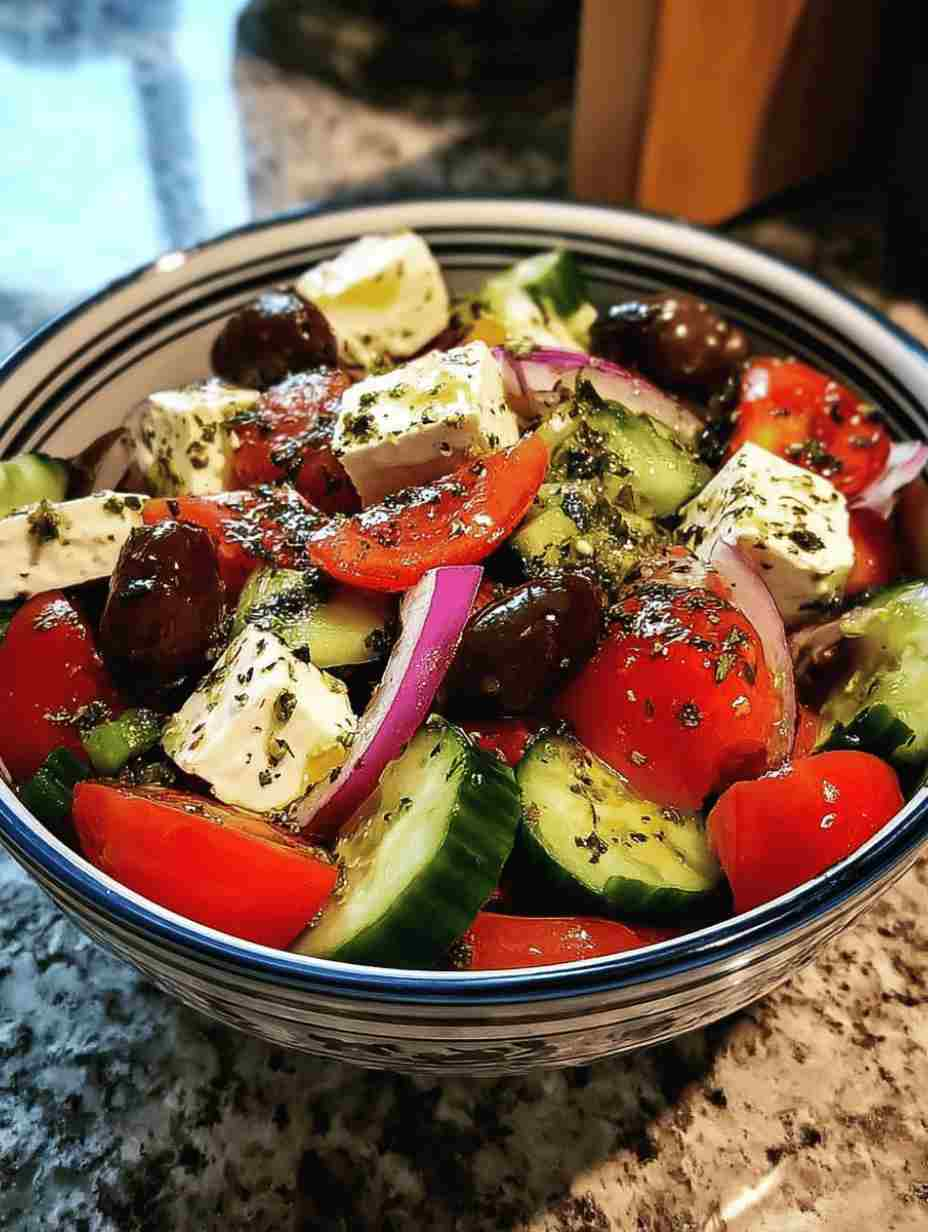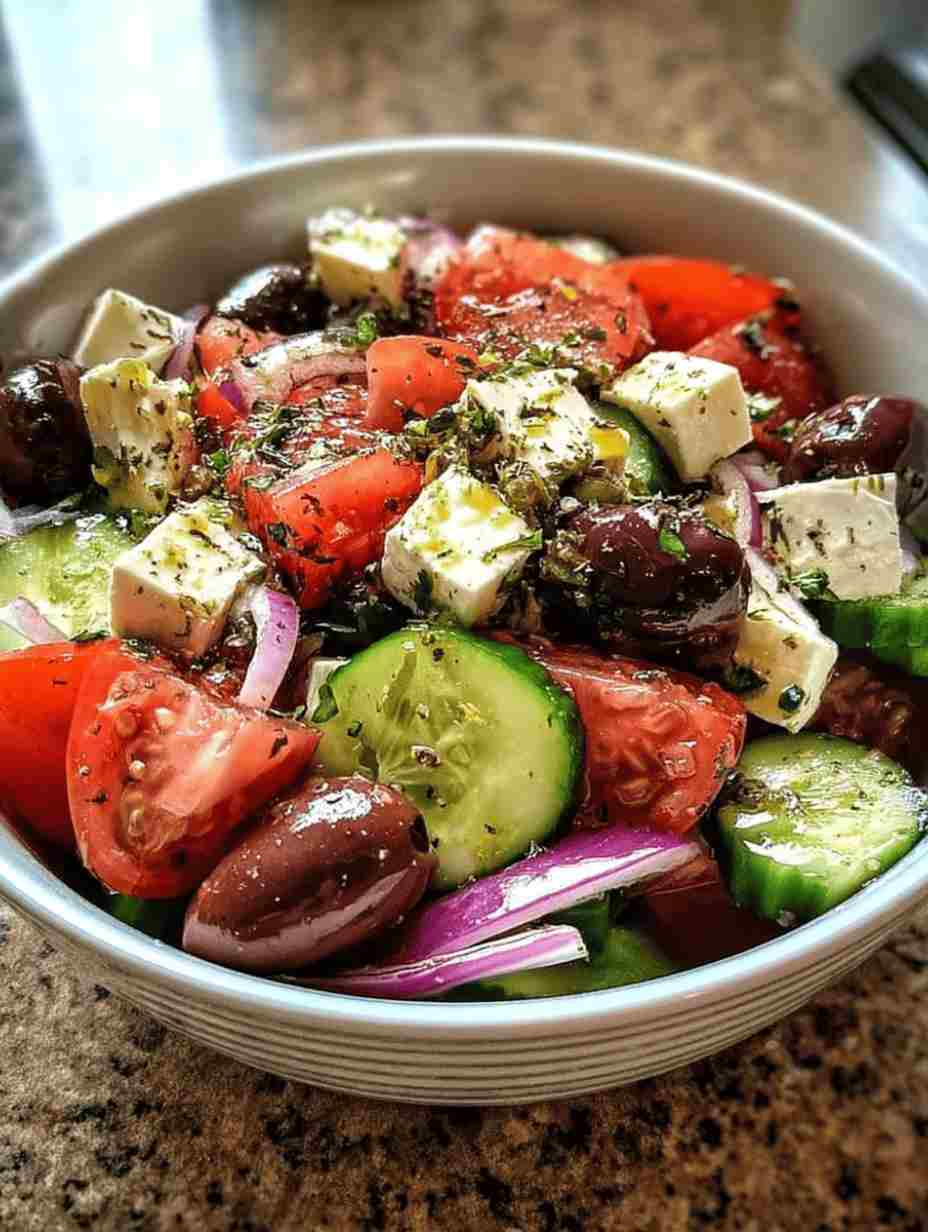A Classic Greek Salad is the ultimate combination of fresh vegetables, briny olives, and creamy feta, all tied together with a simple olive oil and red vinegar dressing. Every bite bursts with flavor—crisp cucumbers, juicy tomatoes, tangy onions, and rich, salty cheese. This dish is not just refreshing but also deeply satisfying, making it a perfect choice for everything from light weeknight dinners to summer cookouts and elegant dinner parties.
If you’re searching for easy appetizer ideas, healthy comfort food, or quick party food that delivers maximum flavor with minimal effort, this Classic Greek Salad is the answer. It’s a versatile dish that works as a side, starter, or even a main meal with the right accompaniments. Plus, it’s naturally vegetarian, gluten-free, and packed with nutrients, making it as wholesome as it is delicious.
Why You’ll Love This Recipe
-
Quick & easy – Ready in just minutes with simple ingredients.
-
Healthy & light – A wholesome option filled with vitamins and antioxidants.
-
Versatile – Serve as a side dish, appetizer, or light main course.
-
Crowd-pleasing – Perfect for gatherings, potlucks, and holiday spreads.
-
Authentic flavor – Inspired by the traditional flavors of Greece.
-
No cooking required – Just slice, toss, and enjoy.
Ingredient Breakdown
Cucumbers: Crisp and refreshing, they form the crunchy base of the salad.
Cherry Tomatoes: Juicy and slightly sweet, they balance the salty and tangy elements.
Red Onion: Adds sharpness and depth, cutting through the richness of the cheese and olives.
Kalamata Olives: A staple of Greek salads, offering briny, bold flavor.
Green Olives: Provide a slightly different, milder saltiness that complements the darker Kalamata olives.
Feta Cheese: Creamy, tangy, and salty—it ties the whole salad together.
Fresh Parsley: Adds brightness and a fresh herbal note.
Dried Oregano: A signature Greek seasoning that enhances the Mediterranean flavors.
Salt & Pepper: Essential for balancing and elevating the overall taste.
Olive Oil: Smooth, rich, and heart-healthy—the foundation of the dressing.
Pro Tips
-
Use block feta, not pre-crumbled: Freshly cubed feta has better texture and flavor.
-
Slice onions thinly: This prevents them from overpowering the other ingredients.
-
Chill before serving: A brief chill helps the flavors meld and makes the salad more refreshing.
-
Drizzle dressing just before serving: This keeps the vegetables crisp.
-
Go for high-quality olive oil: A good extra-virgin olive oil will elevate the entire dish.
Ingredient Swaps or Variations
-
Cheese alternatives: Replace feta with goat cheese or fresh mozzarella for a milder option.
-
Vegan version: Use dairy-free feta or skip the cheese entirely and add extra olives or avocado.
-
Add protein: Toss in grilled chicken, shrimp, or chickpeas to make it a full meal.
-
Different herbs: Fresh mint, dill, or basil can add a unique twist.
-
Extra veggies: Add bell peppers, capers, or artichoke hearts for more variety.
Serving Suggestions
A Classic Greek Salad shines on its own but pairs beautifully with a variety of dishes:
-
Serve alongside grilled meats like lamb, chicken souvlaki, or steak.
-
Pair with warm pita bread and hummus for a Mediterranean spread.
-
Offer as a starter for a multi-course dinner.
-
Enjoy as a light main course with quinoa or couscous on the side.
-
Use it to balance heavier comfort food dishes with a refreshing, healthy element.
Make Ahead + Storage Tips
-
Make ahead: You can chop the vegetables and prepare the cheese up to 24 hours in advance. Keep them stored separately in the fridge until ready to assemble.
-
Dressing storage: Mix the olive oil and vinegar in a jar and store in the fridge. Shake well before using.
-
Refrigeration: Once assembled, store leftovers in an airtight container in the fridge for up to 2 days.
-
Avoid sogginess: If making ahead, add dressing just before serving to keep vegetables crisp.
-
Refreshing leftovers: Add a few fresh tomato wedges or cucumber slices before serving again.
Cultural or Historical Notes
The Greek Salad, or “Horiatiki,” is a staple of Mediterranean cuisine, traditionally made with simple, fresh ingredients available in Greek villages. Unlike many Western versions, authentic Greek salads do not contain lettuce. Instead, they highlight cucumbers, tomatoes, olives, onions, and feta, dressed with olive oil and oregano. This rustic dish reflects the heart of Greek dining—fresh, seasonal ingredients, bold flavors, and communal sharing. It’s a timeless recipe that continues to delight across cultures and generations.
Frequently Asked Questions (FAQ)
1. Does Greek Salad traditionally have lettuce?
No, authentic Greek Salad does not include lettuce. It’s focused on fresh vegetables, feta, and olives.
2. Can I use bottled dressing instead of olive oil and vinegar?
While you can, homemade dressing is far more flavorful and authentic. A simple olive oil and vinegar combo is all you need.
3. What type of olives work best in Greek Salad?
Kalamata olives are the traditional choice, but green olives or a mix can also be used.
4. Can I make Greek Salad vegan?
Yes, simply omit the feta or use a plant-based cheese alternative. The salad is naturally dairy-free without it.
5. How long does Greek Salad last in the fridge?
It’s best enjoyed fresh but can be refrigerated for up to 2 days. Keep the dressing separate until ready to eat for best results.

Classic Greek Salad
Ingredients
Equipment
Method
- Slice the cucumbers and red onion. Halve the cherry tomatoes. Cube the feta cheese.
- In a large bowl, combine the cucumber, cherry tomatoes, red onion, Kalamata olives, and green olives. Add the cubed feta cheese.
- Sprinkle the salad with dried oregano, chopped parsley, salt, and pepper. Drizzle with olive oil

